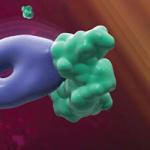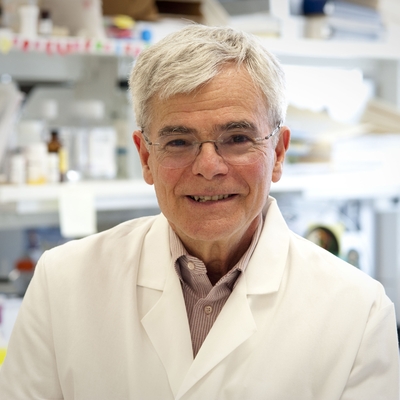Research Topics
Success in treatment of some disseminated cancers with chemotherapy has led to intensified efforts to understand why many other cancers are intrinsically resistant to anticancer drugs or become resistant to chemotherapy after many rounds of treatment. Work in the Multidrug Resistance Section has revealed that a major mechanism of resistance of cancer cells to natural product anticancer drugs such as Adriamycin, etoposide, vinblastine, actinomycin D, and Taxol is expression of an energy-dependent drug efflux pump, termed P-glycoprotein (P-gp, encoded by the ABCB1 gene), or the multidrug transporter. This pump system contributes to drug resistance in about 50 percent of human cancers by preventing accumulation of powerful anticancer drugs in cancer cells. The sequence of the ABCB1 gene, determined in our laboratory, has led to (1) a model of the transporter as a pump with 12 transmembrane domains and two ATP sites, and (2) the discovery of a related family of 48 human ABC transporters involved in a variety of essential transport processes in cells. Polymorphisms in the ABCB1 gene, including the "silent" polymorphism C3435T (no amino acid change) affect drug resistance and sensitivity to inhibitors, probably by changing mRNA structure and the rate of translation. At least a dozen other ABC transporters may contribute to drug resistance in cancer. While the studies on the mechanism and function of P-gp and related ABC transporters in cultured cancer cells has led to a better understanding of possible mechanisms of multidrug resistance and novel ways to circumvent or target resistance such as the super-sensitivity of P-gp-expressing cells to some drugs, clinical relevance is still unclear.
One of the recognized roles for ABC transporters, especially P-gp and ABCG2, is that of limiting drug penetration into the brain. While knockout mouse models have been invaluable in defining the role of P-gp and ABCG2 at the blood-brain barrier, these models are expensive and not amenable to high-throughput assays. The zebrafish has been suggested as a possible alternative to the mouse model; however, little data are available with regard to homologous transporters. Zebrafish do not have a direct homolog of ABCB1 but instead have 2 similar genes, abcb4 and abcb5. In addition, zebrafish have 4 homologs of human ABCG2—abcg2a, abcg2b, abcg2c, and abcg2d. We are currently localizing these transporters in the zebrafish and characterizing their substrate specificity to determine the feasibility of the zebrafish as a model for transporters at the human blood-brain barrier. Additionally, we are developing novel zebrafish-based reporter assays to model transporter inhibition at the blood-brain barrier.
Ongoing projects in the laboratory include genome-wide CRISPR screens to identify novel mechanisms of resistance to various chemotherapy agents in cell line models. In particular, we are interested in the mechanisms of resistance to platinum-based drugs and taxanes, as these are frequently used to treat ovarian cancer. Novel resistance mechanisms discovered from cell line models will be queried against a cohort of RNA Seq data from ovarian cancer tumor samples obtained after debulking surgery and at the time of relapse. Additionally, we seek to identify novel resistance mechanisms to oxaliplatin in colon cancer models, as oxaliplatin is one of the most effective drugs used to treat colon cancer. Finally, histone deacetylase inhibitors (HDIs) are particularly effective in T-cell lymphomas in the clinic, but relatively few resistance mechanisms have been reported. CRISPR screens identifying novel resistance mechanisms may lead to more responses in T-cell lymphomas when HDIs are combined with other targeted therapies.
While overexpression of ABCB1, ABCC1 or ABCG2 is known to confer a multidrug resistance phenotype, other ABC transporters may also contribute to drug resistance in cancer. We are therefore developing a CRISPR-based system to examine the role of all 48 ABC transporters in the development of resistance to a given chemotherapy. This system can be used with any cell line model of choice and with any cytostatic or cytotoxic compound.
Biography
Dr. Gottesman obtained his M.D. from Harvard University Medical School, completed his internship and residency in medicine at the Peter Bent Brigham Hospital in Boston, and received his postdoctoral research training in molecular genetics with Martin Gellert at the NIH. After a year as an assistant professor in the Department of Anatomy at Harvard, he moved to the NIH in 1976. He currently serves as chief of the Laboratory of Cell Biology. From 1994-2022, he served as the Deputy Director for the Intramural Research, NIH. Dr. Gottesman has received several awards including the Dr. Nathan Davis Award for Outstanding Member of the Executive Branch in Career Public Service from the the American Medical Association and was a finalists for Career Achievement Category of the Service to America (SAMMIE) Award. He was elected to the National Academy of Science and the Institute of Medicine of the National Academies (now National Academy of Medicine).
Selected Publications
- Gillet JP, Calcagno AM, Varma S, Marino M, Green LJ, Vora MI, Patel C, Orina JN, Eliseeva TA, Singal V, Padmanabhan R, Davidson B, Ganapathi R, Sood AK, Rueda BR, Ambudkar SV, Gottesman MM. Redefining the relevance of established cancer cell lines to the study of mechanisms of clinical anti-cancer drug resistance. Proc Natl Acad Sci U S A. 2011;108(46):18708-13.
- Kimchi-Sarfaty C, Oh JM, Kim IW, Sauna ZE, Calcagno AM, Ambudkar SV, Gottesman MM. A "silent" polymorphism in the MDR1 gene changes substrate specificity. Science. 2007;315(5811):525-8.
- Thorgeirsson SS, Huber BE, Sorrell S, Fojo A, Pastan I, Gottesman MM. Expression of the multidrug-resistant gene in hepatocarcinogenesis and regenerating rat liver. Science. 1987;236(4805):1120-2.
- Chen CJ, Chin JE, Ueda K, Clark DP, Pastan I, Gottesman MM, Roninson IB. Internal duplication and homology with bacterial transport proteins in the mdr1 (P-glycoprotein) gene from multidrug-resistant human cells. Cell. 1986;47(3):381-9.
- Cabral F, Sobel ME, Gottesman MM. CHO mutants resistant to colchicine, colcemid or griseofulvin have an altered beta-tubulin. Cell. 1980;20(1):29-36.
Related Scientific Focus Areas



Molecular Biology and Biochemistry
View additional Principal Investigators in Molecular Biology and Biochemistry

This page was last updated on Wednesday, March 20, 2024
